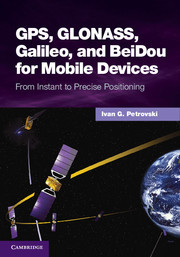Description
GPS, GLONASS, Galileo, and BeiDou for Mobile Devices
From Instant to Precise Positioning
Author: Petrovski Ivan G.
Get up to speed on GNSS for mobile applications with this practical guide, including step-by-step algorithms and key methods for future systems.
Language: English
Subject for GPS, GLONASS, Galileo, and BeiDou for Mobile Devices:
Approximative price 111.58 €
In Print (Delivery period: 14 days).
Add to cart
Publication date: 05-2014
336 p. · 17.8x25.2 cm · Hardback
336 p. · 17.8x25.2 cm · Hardback
Description
/li>Contents
/li>Biography
/li>
Get up to speed on all existing GNSS with this practical guide. Covering everything from GPS, GLONASS, Galileo, and BeiDou orbits and signals to multi-GNSS receiver design, AGPS, RTK, and VRS, you will understand the complete global range of mobile positioning systems. Step-by-step algorithms and practical methods provide the tools you need to develop current mobile systems, whilst coverage of cutting edge techniques, such as the instant positioning method, gives you a head-start in unlocking the potential of future mobile positioning. Whether you are an engineer or business manager working in the mobile device industry, a student or researcher, this is your ideal guide to GNSS.
Introduction; Part I. GNSS: Orbits, Signals and Methods: 1. GNSS ground and space segments; 2. GPS, GLONASS, Galileo and BeiDou signals; 3. Stand-alone positioning with GNSS; 4. Referenced positioning with GNSS; Part II. From Conventional to Software GNSS Receiver Double Back: 5. Generic GNSS receiver operation; 6. Software receiver: toy or foe?; 7. Common approach; Part III. Mobile Positioning at Present and in the Future: 8. Positioning with data link : from AGNSS to RTK; 9. Positioning without data link: from BGPS to PPP; 10. Trends, opportunities and prospects; Part IV. Testing Mobile Devices: 11. GNSS simulators; 12. Testing procedures; Index.
Ivan G. Petrovski leads the development of GNSS applications at iP-Solutions, Japan. He has over 25 years' worth of research and development experience in the GNSS field and has previously led GNSS-related R&D for DX Antenna, GNSS Technologies Inc., and the Institute of Advanced Satellite Positioning at TUMSAT. He has academic experience working as an associate professor with MAI and a guest professor with TUMSAT. As an engineer he has developed RTK software, pseudolite systems, instant positioning methods and algorithms, a real-time GNSS software receiver, GNSS signal recorder and RF signal simulator.
© 2024 LAVOISIER S.A.S.




